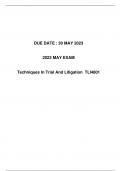DUE DATE : 30 MAY 2023
2023 MAY EXAM
Techniques In Trial And Litigation TLI4801
,QUESTION 1: CIVIL PRACTICE
1.1
A) Discuss the type of court proceedings that will be used to institute
WoodPeckers (Pty) Ltd’s claim.
If the claim is instituted in the Small Claims Court, WoodPeckers (Pty) Ltd will use a
combined summons form that is prescribed by the Small Claims Courts Act 61 of 1984. The
summons will be served on Ms. Zim in person or by registered mail, and will require her to
appear in court on a specific date to defend the claim.
If the claim is instituted in the Magistrate's Court or the High Court, WoodPeckers (Pty) Ltd
will use a combined summons form that is prescribed by the relevant court rules. The
summons will be served on Ms. Zim in person or by registered mail, and will require her to
file a notice of intention to defend the claim within a specified period, failing which judgment
may be entered against her.
In this case, since the debt is R 500,000 and WoodPeckers (Pty) Ltd may institute the claim
in either the Magistrate's Court or the High Court.
B) Discuss whether summary judgment may be used in the above instance. (4)
Summary judgment is a legal process that allows a plaintiff to obtain a judgment without a
trial if there is no genuine dispute of material fact and the plaintiff is entitled to judgment as
a matter of law.
In the instance of WoodPeckers (Pty) Ltd's claim against Ms. Zim, summary judgment may
be used if it can be shown that there is no genuine dispute of material fact and that
WoodPeckers (Pty) Ltd is entitled to judgment as a matter of law.
However, summary judgment is not always appropriate or available in every case. In South
Africa, the rules of court provide that summary judgment may be granted in certain
circumstances, such as where the defendant has no defence to the claim or where the
defendant's defence is frivolous or vexatious. In order to obtain summary judgment, the
, plaintiff must show that there is no triable issue of fact and that it is entitled to judgment
as a matter of law.
In the case of WoodPeckers (Pty) Ltd's claim against Ms. Zim, it is not clear whether
summary judgment would be appropriate or available. If Ms. Zim has a genuine defence to
the claim or if there are material facts in dispute, summary judgment may not be
appropriate.
(c) Assuming that there is no application for summary judgment, name and discuss
the pleading that must be drafted by the plaintiff in response to the defendant’s
intention to defend the matter.
If the defendant files a notice of intention to defend the matter, the plaintiff must draft a reply
or plea to respond to the defendant's defence.
The reply or plea is a formal written statement that sets out the plaintiff's response to the
defendant's notice of intention to defend. The reply or plea must contain a clear and concise
statement of the material facts on which the plaintiff relies, and must also identify any legal
defences that the plaintiff may have.
In the reply or plea, the plaintiff must address the issues raised by the defendant's defence
and provide evidence to support the plaintiff's case. The reply or plea should also address
any counterclaims or set-offs that the defendant may have raised.
It is important for the plaintiff to draft a clear and concise reply or plea, as this will help to
streamline the litigation process and avoid unnecessary delays or confusion. The reply or
plea should be drafted in accordance with the rules of court and should be served on the
defendant within the time period prescribed by the court rules.
In summary, the plaintiff must draft a reply or plea in response to the defendant's notice of
intention to defend the matter. The reply or plea should set out the material facts on which
the plaintiff relies, identify any legal defences, address the issues raised by the defendant's
defence, and provide evidence to support the plaintiff's case. The reply or plea should be
clear, concise, and drafted in accordance with the rules of court.
(d) Draft the pleading referred to in (c) above. It must include inter alia, a heading, the
description of the parties, their locus standi (if applicable), the court’s jurisdiction,
material facts and the prayer. (20) (e) WoodPeckers (Pty) Ltd requests your advice
about a suitable ADR (alternative dispute resolution) mechanism that may be used to
resolve the dispute with Ms. Zim expeditiously. Discuss briefly whether arbitration or
negotiation is the most suitable ADR mechanism having regard to the given facts and
advise WoodPeckers (Pty) Ltd accordingly.




